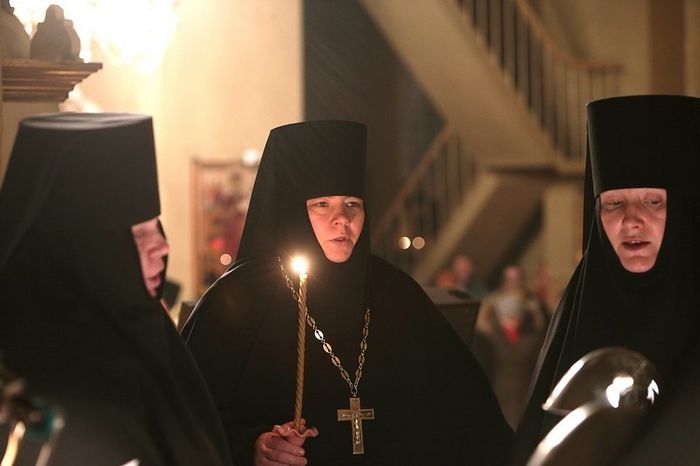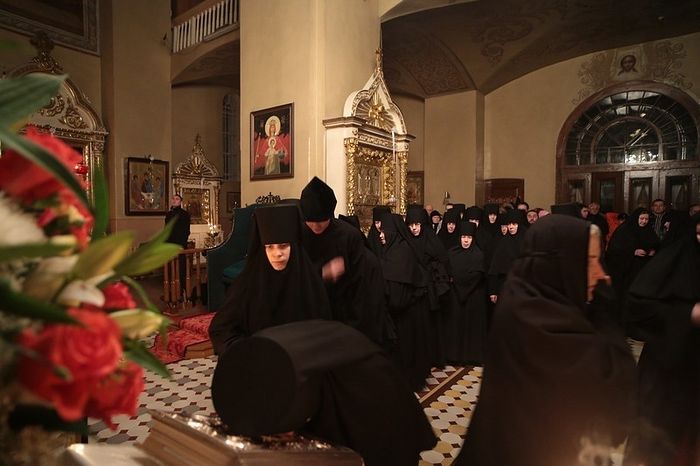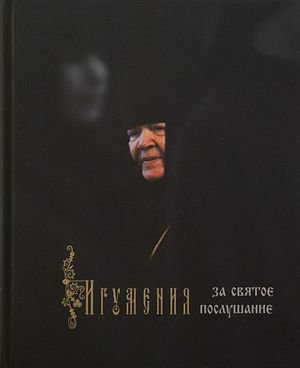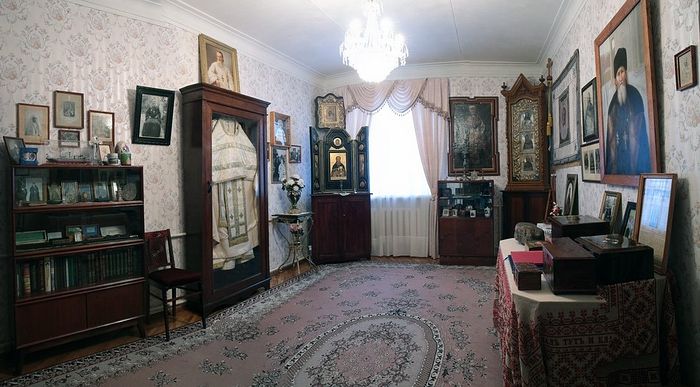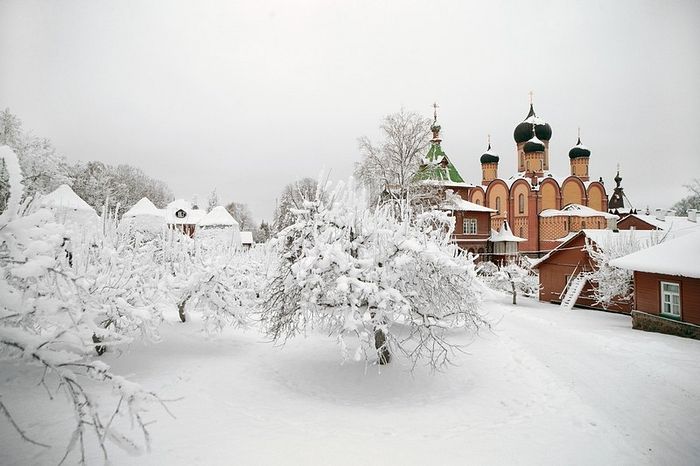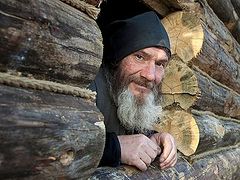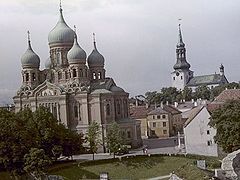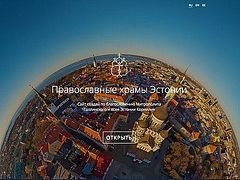The Pukhtitsa Dormition Convent is one of the most beloved monasteries of the Russian Orthodox Church, bearing the special distinction of having never been closed during the godless Soviet years. The monastery’s unbroken line of spiritual continuity has given rise to several notable spiritual figures, such as the previous abbess, the ever-memorable Schema-Abbess Barbara (Trofimova), who reposed on February 8, 2011. Matushka bore the obedience entrusted to her by the hierarchy for more than forty years. In the patriarchal words of condolence about matushka it says, “It is largely thanks to the labors of Schema-Abbess Barbara that Pukhtitsa Monastery became a true outpost of Orthodoxy in Estonia.”
How does a monastery that was never closed in the Soviet years and that has raised up abbesses for many convents in various dioceses of the Russian Orthodox Church live today? Does it preserve the inheritance left by Mother Barbara? We spoke with the current Pukhtitsa mother superior, Abbess Philareta (Kalacheva) on these questions and on monastic life in general.
—Matushka Philareta, in what ways are the peculiarities of the residency of a Russian Orthodox monastery in Estonia manifested today?
—Pukhtitsa Monastery is often called the Zion of the Baltic region. It is a place sanctified by the appearance of the Mother of God and the finding of her wonderworking icon, especially blessed and dear to the heart of every Orthodox person. As a century ago, our monastery realizes a service to the Church and people in Estonia under the protection of the Most-Pure Mother of God. Pukhtitsa Monastery was created as an abode of love and mercy. Receiving guests and pilgrims, we feel the mutual sympathy, respect and love of the locals for the monastery. We want to continue to preserve this tradition of warm, peaceful relations in the future.
—By today’s standards, your monastery is fairly large—more than 100 nuns. There is developed farming—of the land, and livestock. Not long ago, you said in an interview that few young people come to the monastery now, and therefore, few working hands. What do you see as the course of action—to reduce the volume of work or, perhaps, attract more workers from outside? Is the former useful for the monastery, from your point of view?
—We absolutely cannot reduce the amount of work: We live on what we grow and receive from our natural resources and we also receive and provide all that is necessary for the many pilgrims flocking to Pukhtitsa year-round. In modern times, we have the possibility to more mechanize our manual labor, widely using farming machinery, and this enables us to significantly alleviate the sister’s obediences.
—In connection with the necessity of engaging hired labor, do you manage to avoid the loss or neglect of the sisters’ spiritual and prayer life?
—Of course, the monastery has permanent workers, doing the work that the sisters of the monastery cannot. This includes maintenance and plumbing, and work in carpentry and metal workshops. As a rule, they are believers, family people, and such a practice can in no way influence the prayer life of the sisters of the monastery, because these are different planes, existing separately from one another.
—Do many pilgrims come to the monastery today? What do the sisters try to tell guests about, besides the history of the monastery?
—Yes, quite a number of pilgrims come to the monastery today. The sisters lead tours for them, tell them about the history of the monastery, and pilgrims visit the museum. Whoever wants to stay for a longer time helps out with obediences, in the garden, on the farm, in cleaning up the grounds. The sisters serving the pilgrims in the guest houses can answer their questions and help those just beginning their Church lives. Pilgrims have the opportunity to turn to priests in confession with questions of a spiritual nature, and also to speak with the older nuns having more life and spiritual experience; but pilgrims and guests of the monastery must remember that the life of monastics is intimate and should be filled with prayerful attention and bodily labor, therefore to distract the sisters and to persist in wanting to talk is a sinful desire.
—Does the monastery engage in social services?
—Of course! The tradition of Pukhtitsa Monastery as an abode of love and mercy always highly values self-sacrificing service to God in the person of those around us in need of help. And in the very hardest of times, pilgrims have always received room and board in the monastery guest houses, and this tradition of monastery charity is preserved in Pukhtitsa to this day. The monastery has always provided and continues to provide all possible assistance to the poor, a tradition of sharing the gathered harvests with orphanages and hospitals has developed, and on Nativity and Pascha we deliver books and gifts to children with disabilities.
—At the monastic conference in the fall of 2013 in the Trinity-St. Sergius Lavra, the question was often heard during the discussion about how inhabitants of the monasteries are overworked and little time and strength remain for the cell rule of prayer. How is the day organized for the sisters in your monastery?
—The foundation of the Pukhtitsa routine has always been a harmonious combination of prayer and labor. Today the day is arranged just as in the first years of the founding of the monastery. The righteous St. John of Kronstadt loved the Pukhtitsa sisters and said of them, “The Pukhtitsa sisters are taking large steps towards the Heavenly Kingdom.” And actually, the work then was almost unbearable—the first Pukhtitsa nuns had to combine building, the building up of the newly-created monastic habitation, laborious agricultural work on more than 250 acres of land, and the monastic rule. The full monastic liturgical cycle was introduced here in the first year and two monastic choirs were created. Besides that, the Pukhtitsa nuns labored in charitable institutions, cared for the sick in the monastery hospital, and taught orphans to read and handicrafts to children at the monastery’s orphanage. I’m saying all this for comparison.
As our reposed matushka Schema-Abbess Barbara (Trofimova) would often say, labor can be equated with prayer if it is performed with a feeling of especial gratitude to God, as if in His presence, and is perceived as service to the Lord for the good of this holy abode. Such work, done for the glory of God, is called spiritual. The older sisters have said concerning prayer, “You cannot take a fish from a pond without labor,” that is, if you do not work in the sweat of your brow, then your prayer will be empty. Even in the biggest jobs, our sisters do not forget about prayer.
—Can physically weak sisters stay in the monastery?
—What kind of physical weakness are we talking about? About poor health? There are no such healthy monastics—it’s an illusion. Sickness is a necessary cross which monastics bear.
But in the monastery, every person, despite any infirmity, is important and necessary in his own place, as in a complex machine where even the smallest cog is necessary. And each person finds his necessary place of obedience in the monastery, provided that he has love for God and a firm resolve to live and labor in this holy habitation.
The history of Orthodox asceticism shows that physical strength and health are not necessary for salvation. The apostle Paul himself says, [The] strength [of God] is made perfect in weakness (2 Cor. 12:9).
—Matushka, your monastery was never closed in the Soviet years. Everyone who is interested in questions of the spiritual life and women’s monasteries has heard a great deal about the Pukhtitsa eldresses—Matushka Lyubov, Matushka Catherine, Matushka Sergiya. Have you managed to maintain the continuity of spirit and monastic traditions?
—Indeed, Pukhtitsa Monastery has a great advantage—it was never closed for even a day, and that’s very important, because the continuity of monastic traditions was preserved here. Many of the first Pukhtitsa sisters were spiritual children of righteous St. John of Kronstadt and passed on his legacy, preserving his living memory. In the postwar years, many of our sisters were cared for by the experienced God-bearing elder Hiero-Schemamonk Simeon (Zhelnin) of the Pskov Caves Monastery, now numbered among the saints, and were guided by his instructions. Moreover, about eight decades of the monastery’s history were consecrated by the spiritual feats of our blessed eldresses the nuns Elena (Kushaneva) and the nun Catherine (Malkov-Panina), who bore the heavy asceticism of foolishness-for-Christ’s-sake in the monastery.
There were spiritually-experienced nuns laboring in Pukhtitsa, and the younger generation had the opportunity not only to see their examples, but were blessed to serve them: living in one cell, to speak with spiritually-experienced sisters, to feel and to see their hardships and the grace of the monastic life with their own eyes. Therefore, continuity is a living tradition which is transmitted as the spiritual experience of the life of a wise generation to the young generation. It is always touching… After all, the life of the older nuns remains in our memory, because they themselves gave us a piece of their hearts and souls. So many experiences, prayers, and their involvement has been invested in the life of young novices. There are wonderful sisters—Matushka Schema-Abbess Barbara, Schemanun Photina, Schemanun Lyubov, Schemanun Iona, Nun Euphrosynia, and so on—who are unforgetable and whose spiritual feats are difficult to overestimate. In complex, unresolvable, difficult situations for the heart, one cannot help but think of how they would act in your place.
—Tell us, please, a little about the Pukhtitsa eldresses.
—The book Abbess as a Holy Obedience, the fruit of the labors of the sisters of the monastery, dedicated to the memory of Schema-Abbess Barbara (Trofimova), who led Pukhtitsa Monastery for more than forty years, was just published. The book was presented at the Second Pukhtitsa Readings in December 2013. Already-prepared and awaiting publication is a book about the Blessed Nun Ekaterina (Maklov-Panina),[1] widely known beyond the borders of Estonia. Readers will have the chance to learn more about the ascetical life of the remarkable Pukhtitsa ascetics of piety of the twentieth and twenty-first centuries.
—Do the sisters practice the Jesus Prayer?
—Upon monastic tonsure, the sisters receive a cell rule of prayer, and every nun is charged with prayer as a duty. Our cell rule includes the so-called 500.[2] As you know, monastics pray for the whole world, they pray for all people, and they are a mystery: Monks pray in secret.
I must note that our monastery is cenobitic, and laborious, and there are many people. Over the course of 120 years, the experience of total immersion in contemplative prayer has not been here. The prayer of the heart must be taken up with a blessing and under the direction of an experience doer of the Jesus Prayer. The older sisters say that the Lord hears the humble. First, we must learn humility…
—Modern people often hear that the monastic spirit is dying out in our day. What do you think about it?
—People tend to observe, evaluate, and sometimes criticize monastics, but there is a saying: “People see how a monk cavorts, but they don’t see how he weeps.” Of course, it’s impossible to compare us with the ancient ascetics of Egypt, who could, for example, fast for many days, eating nothing, undertaking many hours of prayerful vigil—unfortunately, modern people no longer have the strength for such asceticism. But monasticism is always the same, just as man is one and the same.
I think every time has its own podvig, and modern monastics can also labor according to their strength and receive Divine grace like the ancient ascetics. Thus, in my view, it’s premature to talk about the extinction of the monastic spirit. It is revealed only to the Lord, and only the Lord can judge each man’s labors, asceticism, and cross-bearing. Monasticism is a mystery; it is intimate.
—Matushka, must a girl who wants to become a nun first receive a secular education? Is there a demand in Pukhtitsa for knowledge gained in the world?
—I don’t think these things are interconnected, and secular education is not a condition or prerequisite for entering a monastery; but knowledge gained by the sisters in the world, is, of course, used when necessary, and there are many such examples in our monastery.
—Tell us, please, a bit about how you became a nun. Who did you learn monasticism from; who was your example in the monastic life?
—My path to monasticism wasn’t anything special or unusual. During my summer breaks from school, I would visit Pukhtitsa Monastery with the blessing of my spiritual father, working together with the sisters in the “hot” time of haymaking, and I saw the monastic life with my own eyes and was so imbued with the blessed atmosphere, the prayer life, the spiritual work of obediences, the feeling of a united monastic life, that by the end of the summer I didn’t want to leave. When it came time to leave, I found no place for myself anywhere, and as soon as I graduated and received my diploma, I immediately came to the monastery for permanent residence, and any other kind of life was simply impossible for me. I attribute all of this to the work of grace—only Divine grace can wrest a man from his environment and lead him to monasticism.
—How would you advise a girl desiring monasticism to choose a monastery? What is necessary to consider, in your view (perhaps climate, obediences, the spirit of the monastery), and what must you know about yourself and about the monastery, having decided to leave the world?
—There is only one case in which someone can become a monastic: If there is a calling from God. It is expressed in a strong, irresistible desire for the monastic life. All that was dear and sweet for your heart in the world becomes unbearably oppressive. The sisters have said, “All is well; you have your mama, papa, brother, and sister at home; everyone loves you; but it is impossible for you to be there, just as you choke without air.”
As for choosing a monastery, I think the heart will tell you, it won’t deceive you, and you will feel that precisely here is your place. Then you should consult about it and receive a blessing from your spiritual father.
For those desiring to enter a monastery, it’s important to know what they are searching for when they go to a monastery, and what they expect when they turn to Christ. Then, they either go to find the wholeness and fullness of the inner life, or for Christ to resolve this or that theoretical question for them which concerned them. It’s very important. Will you go to Christ as to your Deliverer from spiritual sorrow, from weakness of will, which each of us bears within ourselves, that the Lord might give us strength to labor, or as to a philosopher for resolving our doubts? It’s necessary to understand, because in this or that case you receive different results. One of the greats said that the realm of doubt is just as endless as the realm of thoughts. Now it is one of the reasons to advise those desiring to enter a monastery again and again to test themselves and make sure that the path of your spiritual life is going not from theory to life, but from life to theory, not from doubts to Christ, but from Christ to the resolution of doubts, not from the mind to the heart, but from the heart to the mind.
The logic of those desiring it is strange: “I love the Lord and I want to go to a monastery, but I’m afraid and I have doubts!” This cannot be. If you love Christ, then you believe firmly, and if you believe, then you trust, and if it is so, then there can be no doubts!

